RELATED RATE OF CHANGE WORD PROBLEMS
Subscribe to our ▶️ YouTube channel 🔴 for the latest videos, updates, and tips.
Problem 1 :
Brian is standing on a 6-meter ladder that is leaning against a wall when Roger begins to pull the bottom of the ladder out away from the wall. The bottom of the ladder is pulled at a constant rate of 0.5 m/s.
a. How fast is the top of the ladder moving when it is 5 meters up the wall?
b. How fast is the angle formed between the ladder and ground changing at this instant?
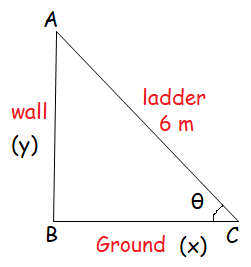
Solution :
When Roger begins to pull the bottom of the ladder out away from the wall, there should be changes in x and y.
x2 + y2 = 62
When y = 5, x = ?
x2 + 52 = 62
x2 = 36 - 25
x = √11
a) Differentiating with respect to t, we get
2x + 2y (dy/dt) = 0
Applying x = √11 and y = 5, we get
2 √11 + 2(5) (dy/dt) = 0
dy/dt = -2√11/10
dy/dt = -√11/5 m/sec
b) Rate of change between ground and ladder.
cos θ = Adjacent side/hypotenuse
cos θ = x/6
-sin θ (dθ/dt) = (dx/dt)(1/6)
The bottom of the ladder is pulled at a constant rate of 0.5 m/s.
dx/dt = 0.5 m/s
-(5/6) (dθ/dt) = (0.5)(1/6)
(dθ/dt) = -(0.5)(1/6)(6/5)
(dθ/dt) = -0.1 (or) -1/10 radian/sec
Problem 2 :
The radius of a sphere is increasing at a constant rate of 2 in/min. Find the rate of change of the volume of the sphere when the radius is 6 inches and 24 inches
Solution :
Let r be the radius of sphere.
Calculating rate of change when r = 6 :
Calculating rate of change when r = 24 :
Problem 3 :
A point is moving along the graph of y =√x in a manner such that dx/dt = 3 cm/sec. Find dy/dt, when x = 4.
Solution :
Problem 4 :
Find the rate of change of the distance between the origin and a point moving on the graph of y = sinx if the rate of change of the x-coordinate with respect to time at x = π is 2 cm/sec.
Solution :
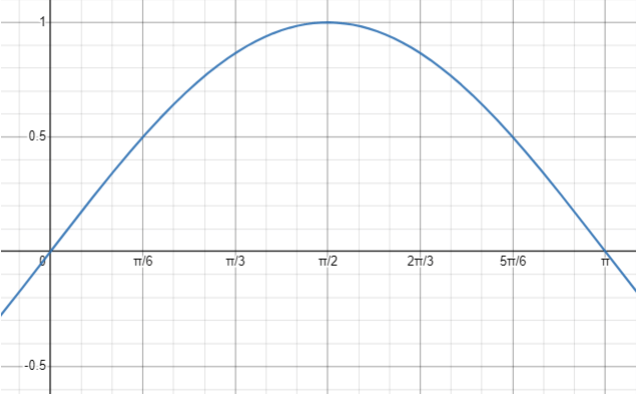
Solution :
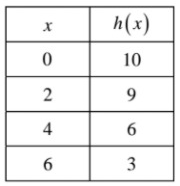
Let L be the distance between the origin and a point moving on the curve.
x2 + y2 = L2
x2 + (sin x)2 = L2
Differentiating with respect to t.
2x (dx/dt) + 2 sinx cos x dx/dt = 2L (dl/dt)
x = π dx/dt = 2 cm/sec.
2 π(2) + 2 sin π cos π (2) = 2L (dl/dt)
4 π + 0 = 2L (dL/dt) ----(1)
To find the value of L,
x2 + (sin x)2 = L2
When x = π
π2 + (sin π)2 = L2
L = π
Applying the value of L in (1), we get
dL/dt = 4 π/2 π
dL/dt = 2 cm/sec
Problem 5 :
All edges of a cube are expanding at a rate of 3 cm/sec. How fast is the volume changing when each edge of the cube is 10 cm? How fast is the surface area of the cube changing at this instant?
Solution :
Let x be the side length of cube.
dx/dt = 3 cm/sec
Volume of cube (V) = a3
Surface area of cube (S) = 6a2
Rate of change of volume :
dV/dt = 3a2 (da/dt)
When a = 10, da/dt = 3 cm/sec
dV/dt = 3(10)2 (3)
dV/dt = 900 cm3/sec
Rate of change of surface area :
dS/dt = 12a (da/dt)
When a = 10, da/dt = 3 cm/sec
dS/dt = 12(10) (3)
dS/dt = 360 cm2/sec
Problem 6 :
A baseball diamond has the shape of a square with sides 90 feet long (see figure). A player running from second base to third base at a speed of 28 feet per second is 30 feet from third base. At what rate is the player’s distance, s, from home plate changing?
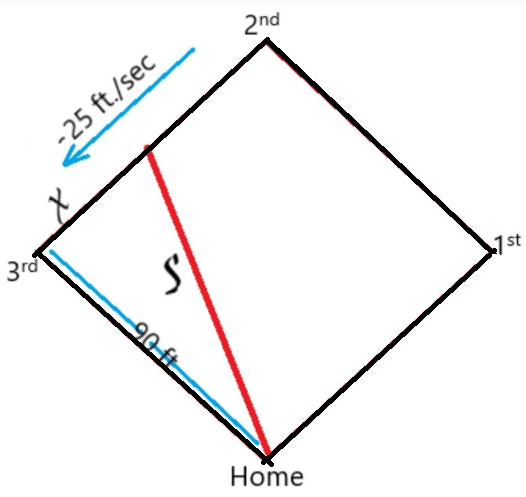
Solution :
Here S and x is changing with respect to t.
902 + x2 = S2
When x = 30
902 + 302 = S2
8100 + 900 = S2
S2 = 9000
S = 3√10
Applying S = 3√10 and dx/dt = -28 (Since the distance is decreasing)
dS/dt = (30/3√10)(-28)
dS/dt = (-280/√10)
Rationalizing the denominator, we get
dS/dt = (-280/√10) (√10/√10)
dS/dt = -28√10 ft/sec
Problem 7 :
A balloon rises at a rate of 30 meters per second from a point on the ground 30 meters from an observer. Find the rate of change of the angle of elevation of the balloon from the observer when the balloon is 30 meters above the ground.
Solution :
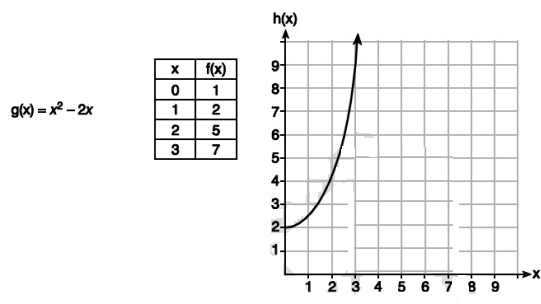
Here y and θ are changing with respect to t.
tan θ = AB/BC ---(1)
tan θ = y/30
sec2θ (dθ/dt) = (1/30) (dy/dt)
To figure out θ, we apply AB = 30
Because we find rate of change in angle of elevation, when the balloon is 30 ft above the ground
tan θ = 30/30
θ = 45 degree
Applying these values in the derivative, we get
sec245 (dθ/dt) = (1/30) (30)
(dθ/dt) = 1/sec245
(dθ/dt) = 1/2 radian/sec
Problem 8 :
Water is flowing into a cone at a rate of 2 cm3/min. The cone has a height of 16 cm and a radius of 4 cm. How fast is the water level rising when it is
(a) 5 cm deep and (b) 10 cm deep?
Solution :
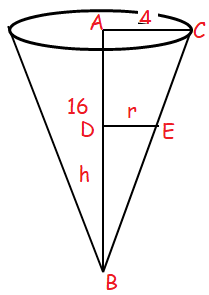
Triangles ABC and DEB are similar.
AB/DB = AC/DE
16/h = 4/r
16r = 4h
r = h/4
When its deep is 5 cm :
When its deep is 10 cm :
Subscribe to our ▶️ YouTube channel 🔴 for the latest videos, updates, and tips.
Recent Articles
-
Finding Range of Values Inequality Problems
May 21, 24 08:51 PM
Finding Range of Values Inequality Problems -
Solving Two Step Inequality Word Problems
May 21, 24 08:51 AM
Solving Two Step Inequality Word Problems -
Exponential Function Context and Data Modeling
May 20, 24 10:45 PM
Exponential Function Context and Data Modeling